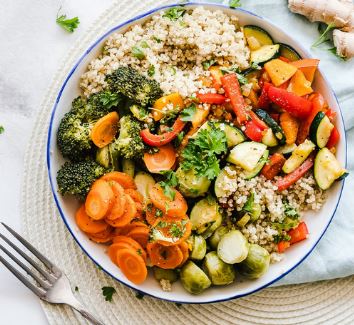
| Registered Dietitians are rock stars. MNT interventions provided by RDs, dramatically lower A1cs. The results say it all. Within 3-6 months of meeting with an RD, people with diabetes can expect an: A1c drop of up to 2.0% with Type 2 Diabetes A1c drop of up to 1.9% with Type 1 Diabetes |
Fiber is a BIG deal
Regular fiber intake decreases the risk of death in people with diabetes.
Yet most Americans don’t get enough roughage in their daily diet. Recommended daily intake of fiber is 14 grams per 1000 calories or about 28 grams per day.
Encourage half of fiber intake to come from whole intact grains. Whole grains still have all three of these parts intact: the bran (the nutritious outer layer), the germ (the seed’s nutrient-rich embryo) and the endosperm (the germ’s food supply, which is high in starchy carbs). They’re typically high in iron, magnesium, manganese, phosphorus, selenium, B vitamins and dietary fiber.
50 percent of fiber from whole grains. Examples per 100gm include:
- Barley (hulled) 17.3 grams /per 100gm
- Brown rice (medium grain) 3.4 gms
- Bulgur 12.5 gms
- Corn (yellow) 7.3 gms
- Oats 10.6 gms
- Rye 15.1 gms
- Sorghum (white) 6.7 gms
- Wheat (hard, white) 12.2 gms
- Wild rice 6.2 gms
50% of fiber from foods naturally high in fiber. Here are a few examples.
- 1 large pear with skin (7 grams)
- 1 cup fresh raspberries (8 grams)
- ½ medium avocado (5 grams)
- 1-ounce almonds (3.5 grams)
- ½ cup cooked black beans (7.5 grams)
- 3 cups air-popped popcorn (3.6 grams)
- 1 cup cooked pearled barley (6 grams)
When it comes to finding foods with fiber, the packaging can be misleading. Food labels provide the most accurate information. Foods that are a good source of fiber have 3 grams per serving and foods that are an excellent source of fiber contain 5 grams per serving.
More weight loss improves outcomes
Prediabetes – For overweight people with prediabetes, new evidence supports losing 7-10% of current weight to reduce diabetes incident by 79%. Adding regular physical activity, including both aerobic and resistance exercise, also contributes to the prevention of type 2 diabetes.
Diabetes – If a person is overweight or obese with diabetes, the most effective weight loss target is 15% or greater to improve outcomes. The previous recommendations of a weight loss of 5-7% are based on the threshold for therapeutic effects. When it comes to weight loss, the greater the weight loss, the greater the benefits.
Eating Patterns – What is best?
There is not enough evidence to support one best approach, but for people with diabetes the research supports the following strategies:
- Emphasize eating more non-starchy vegetables
- Minimize added sugars and refined grains
- Choose whole foods over processed foods
Read the Complete Nutrition Therapy for Adults with Diabetes or Prediabetes – A Consensus Report here.









